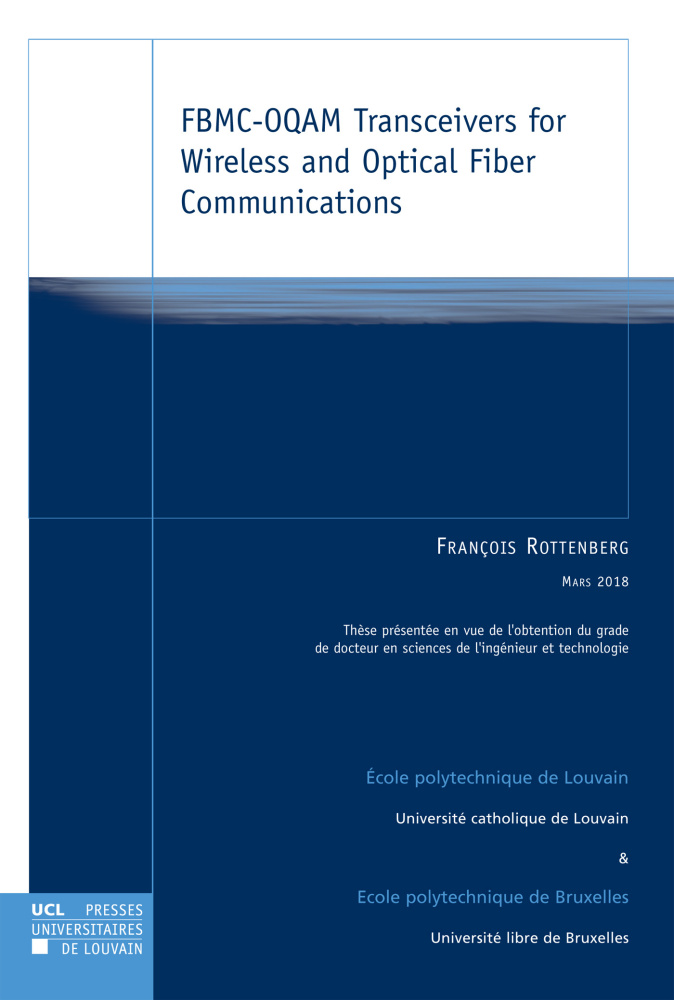FBMC-OQAM transceivers for wireless and optical fiber communications
Première édition
The main objective of this thesis is to investigate the applicability of the FBMCOQAM modulation for next generations of communication systems. More specifically, we focus on two main directions. The first direction studies advanced equalization algorithms for multiple-antenna wireless systems characterized by highly frequency and/or time... Lire la suite
The orthogonal frequency division multiplexing (OFDM) modulation is the most popular multicarrier modulation scheme nowadays. The main advantage of OFDM is its simplicity. However, due to the rectangular pulse shaping of the Fast Fourier transform filters, OFDM systems exhibit very high frequency leakage and poor stopband attenuation. In the light of these limitations, the offset-QAM-based filterbank multicarrier (FBMC-OQAM) modulation has recently received increasing attention. Rather than using a rectangular pulse, FBMC-OQAM uses a pulse shape which is more spread out in time, which results in a much better frequency localization. This in turn translates into higher spectral efficiency and much more flexibility for spectrum allocation.
The main objective of this thesis is to investigate the applicability of the FBMCOQAM modulation for next generations of communication systems. More specifically, we focus on two main directions. The first direction studies advanced equalization algorithms for multiple-antenna wireless systems characterized by highly frequency and/or time selective channels. The second direction studies two main linear impairments in optical fiber systems, namely, phase noise and chromatic dispersion.
Spécifications
- Éditeur
- Presses universitaires de Louvain
- Auteur
- François Rottenberg,
- Collection
- Thèses de l'École polytechnique de Louvain
- Langue
- anglais
- Catégorie (éditeur)
- Sciences appliquées > Informatique > Réseaux et télécommunication
- Catégorie (éditeur)
- Sciences appliquées
- BISAC Subject Heading
- TEC011000 TECHNOLOGY & ENGINEERING / Fiber Optics > TEC041000 TECHNOLOGY & ENGINEERING / Telecommunications
- BIC subject category (UK)
- TJ Electronics & communications engineering > TJK Communications engineering / telecommunications > TJKW WAP (wireless) technology
- Code publique Onix
- 06 Professionnel et académique
- CLIL (Version 2013-2019 )
- 3072 Electronique
- Date de première publication du titre
- 14 juin 2018
Livre broché
- Date de publication
- 14 juin 2018
- ISBN-13
- 978-2-87558676-6
- Ampleur
- Nombre de pages de contenu principal : 286
- Dépôt Légal
- D/2018/9964/14 Louvain-la-Neuve, Belgique
- Code interne
- 96620
- Format
- 16 x 24 cm
- Poids
- 459 grammes
- Type de packaging
- Aucun emballage extérieur
- Prix
- 38,80 €
- ONIX XML
- Version 2.1, Version 3
Google Livres Aperçu
Publier un commentaire sur cet ouvrage
Si vous avez une question, utilisez plutôt notre formulaire de contact
Sommaire
Nomenclature xxii
1 Introduction 1
1.1 Motivations . . . . . . . . . . . . . . . . . . . . . . . . . . 1
1.2 Outline and contributions . . . . . . . . . . . . . . . . . . 4
2 Preliminaries 11
2.1 FBMC-OQAM modulation . . . . . . . . . . . . . . . . . . 12
2.1.1 Limitations of QAM-based multicarrier systems . 12
2.1.2 Advantages of OQAM-based multicarrier systems 17
2.1.3 Discrete-time MIMO FBMC-OQAM transmission
model . . . . . . . . . . . . . . . . . . . . . . . . . 20
2.1.4 Efficient implementation of the SFB and AFB . . . 25
2.1.5 Channel equalization . . . . . . . . . . . . . . . . . 26
2.1.5.1 Conventional approximation of the demodulated
symbols for mildly selective
channels . . . . . . . . . . . . . . . . . . . 26
2.1.5.2 Frequency selective channels . . . . . . . 29
2.1.5.3 Doubly selective channels . . . . . . . . 34
2.1.6 Channel estimation . . . . . . . . . . . . . . . . . . 34
2.2 Communication sytems under study . . . . . . . . . . . . 36
2.2.1 Wireless transceivers . . . . . . . . . . . . . . . . . 36
2.2.2 Optical fiber transceivers . . . . . . . . . . . . . . 39
2.2.3 Radio-over-fiber transceivers . . . . . . . . . . . . 40

